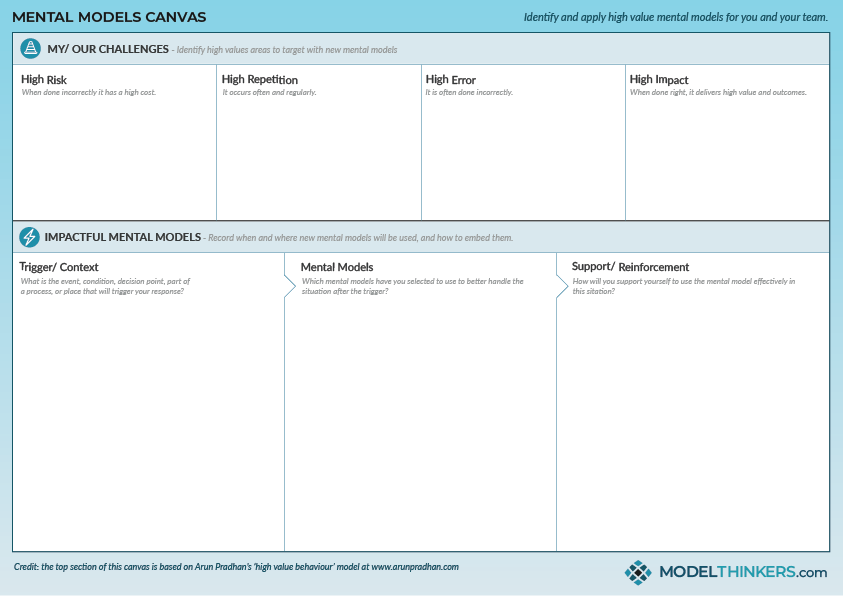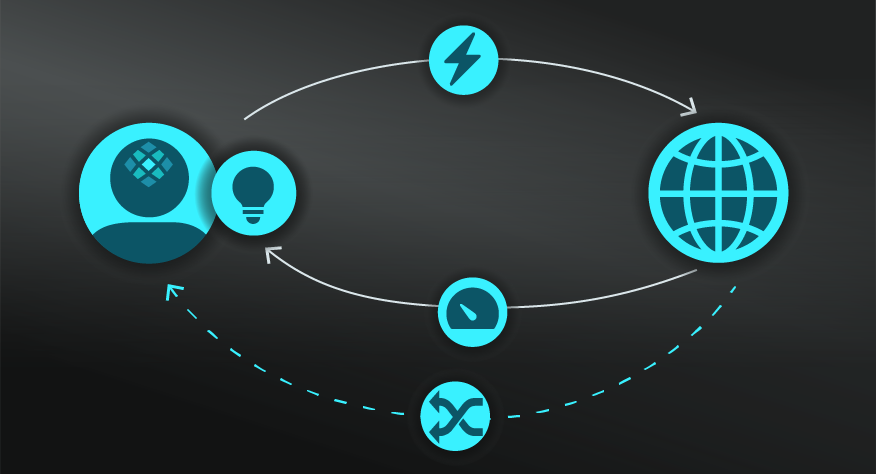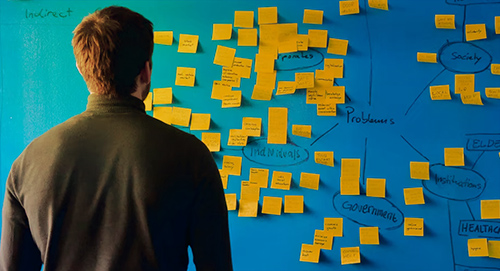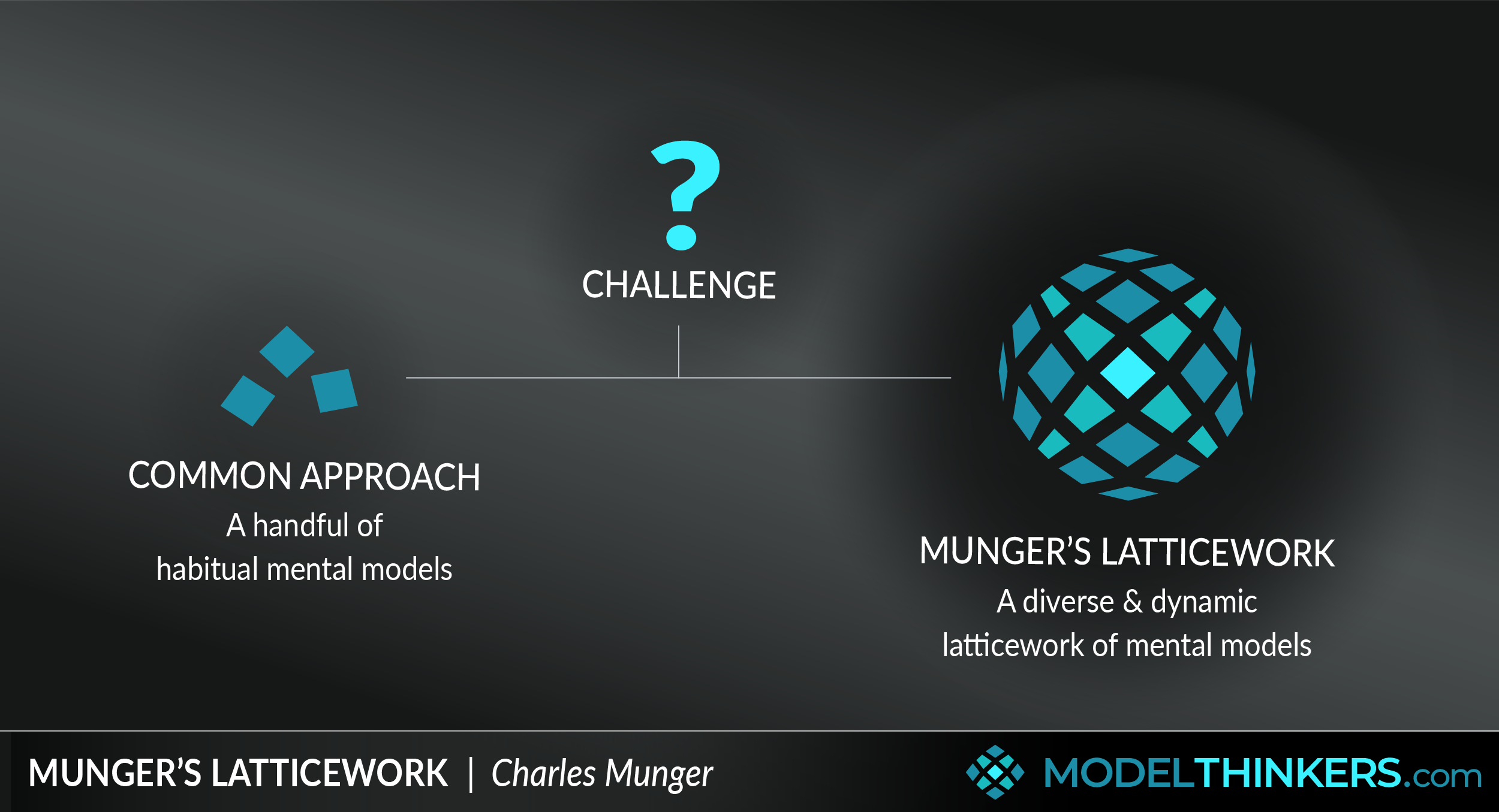
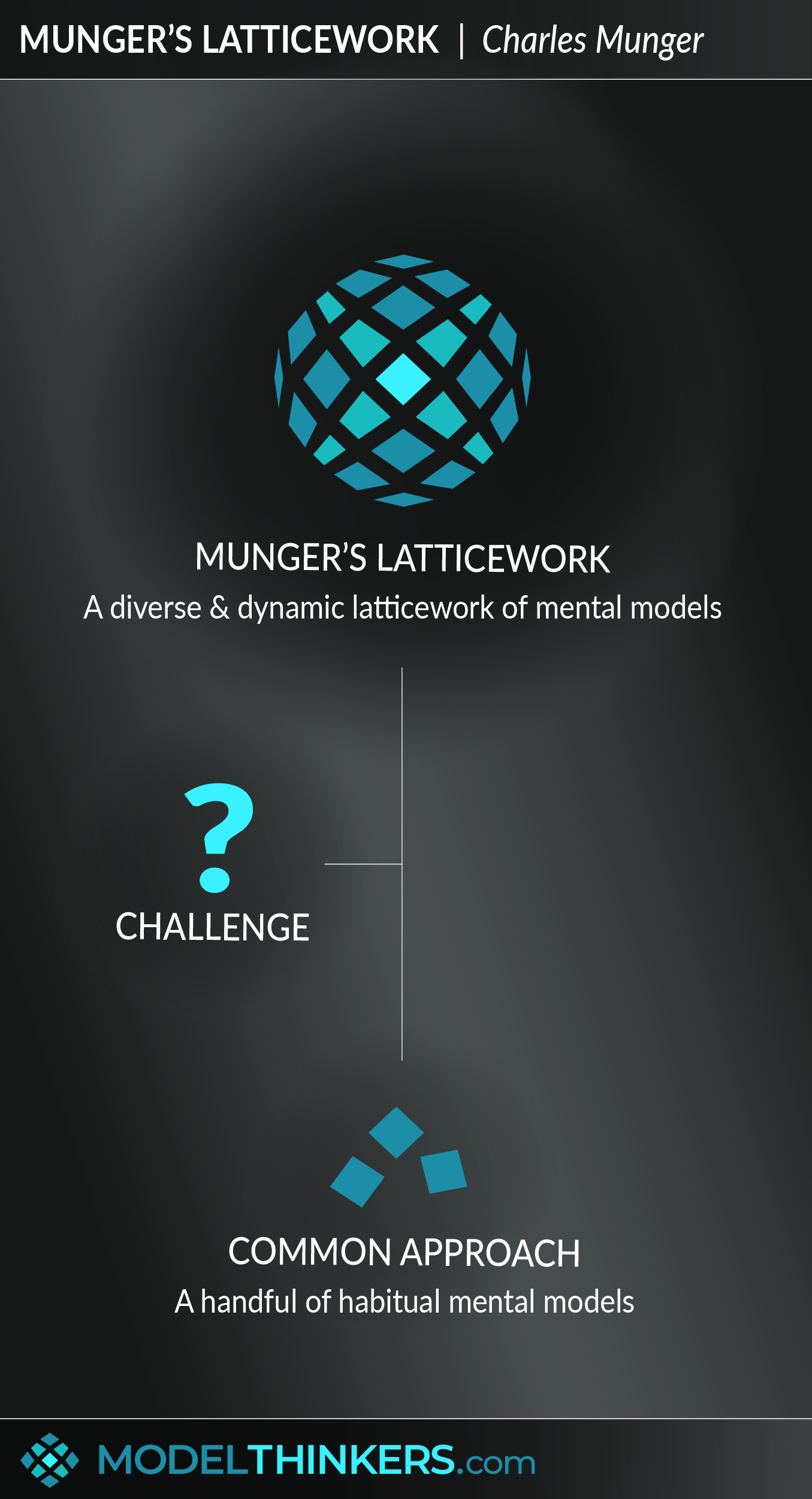
 0 saved
0 saved
 87.9K views
87.9K views








Charles Munger’s Latticework of Mental Models approach to thinking, business and decision making has informed leading investors, executives and entrepreneurs, and was the inspiration behind ModelThinkers.
Mental Models are simplified representations, concepts, and frameworks that allow us to quickly understand ourselves and our world. Everyone uses mental models to understand and act in a complex world. However, most do so unconsciously, using the same handful of models in every situation.
Munger argues that consciously developing and applying a Latticework of Mental Models will empower you to see each problem through a variety of lenses and possible options. It's the difference between solving problems with a single hammer, versus solving them with a dynamic and expansive cognitive toolkit.
MULTIPLE DISCIPLINES.
Munger explains: “Models have to come from multiple disciplines because all the wisdom in the world is not to be found in one little academic department… Fortunately, it isn’t that tough because 80 or 90 important models will carry about 90% of the freight in making you a worldly-wise person.”
That said, Munger points out that there is no ‘master list’ that will work for everyone, rather you will need to build and continually update your list of mental models depending on your challenges, needs and context.
DYNAMIC CONNECTIONS.
Beyond a specific list of isolated models, the real power revealed by Munger was the unique thinking, innovation and creative problem solving that arises through your ability to combine and overlay diverse Mental Models. This involves having clusters of models, or what we call Playbooks, to apply for specific types of challenges.
MAP vs TERRITORY.
At the same time, an important companion model with this one is the Map vs Territory model that points out that, in the words of George Box: "All models are wrong, some of them are useful." This is also another reminder of the importance of using a broad range of models.
VIDEO OVERVIEW.
You can watch the video below for a short overview of this concept. I'll warn you up front that the last bit is a blatant pitch for how to build a latticework of mental models with ModelThinkers, but most of the video is a crash course in mental models and the principle more generally.
BE A MODEL THINKER.
This model has been our inspiration at ModelThinkers — our aim is to help popularise this approach and empower you to develop your own Latticework of Mental Models and dynamically apply those models to transform yourself and the world around you.
That said, whether you use ModelThinkers or not, I'd encourage you to embrace the latticework of mental models approach, as it's incredibly powerful. Who am I kidding... sign up to ModelThinkers and build your latticework faster and more effectively than ever with us!




-
Apply simple criteria to which mental models you use.
When selecting mental models to include into your own latticework, consider whether they support you to better understand yourself and/or the world around you, so you might better effective and impactful action.
-
Collect mental models from diverse domains.
Research a broad range of industries to identify mental models that can be integrated into your area of work or focus.
-
Make connections between mental models.
Rather than holding siloed mental models in your mind, consider how they interact, connect and complement one another.
-
Consider using ModelThinkers to develop your latticework.
You don’t have to use ModelThinkers to develop a latticework of mental models but if you choose to sign up with us to quickly explore, capture, learn and apply your latticework of mental models then be sure to get your value from us with these tips.
-
Use the Choose Mental Models tool.
The canvas, below, will help you to identify high-value areas where new mental models can make the biggest impact on your work and life. It also provides a simple framework to begin to embed using your chosen models.
One challenge, more than a limitation, is ensuring that you consider mental models in relation to each other rather than in isolation. The power of this approach lies in the interplay and overlay between different models.
The main limitation with this model is to consider the limitations of using mental models at all, as they are ultimately inaccurate representations of reality, this is captured by the Map vs Territory model.
The final limitation of this approach lies in the need for constant challenging and unlearning, to renew your latticework. This involves choosing mental models that can challenge one another by taking a different perspective to a problem, to support the interruption of confirmation bias.
The success secret behind Berkshire Hathaway.
Charles Munger is Warren Buffet’s right-hand man and together they have built one of the most consistent and successful business empires that the world has seen. Munger has often identified this latticework of mental model approach as being crucial to their success as it drives their business and investment decisions.
Billionaires aplenty.
While they often use variations in terminology, people such as Jeff Bezos, Bill Gates and Elon Musk have all discussed how they too leverage a latticework of mental models.
For example, Munger explained: “You’ve got to have models in your head. And you’ve got to array your experience — both vicarious and direct — on this latticework of models.”
A similar approach was captured by Musk who said: “It is important to view knowledge as sort of a semantic tree — make sure you understand the fundamental principles, i.e. the trunk and big branches, before you get into the leaves/details or there is nothing for them to hang onto.”
Leading thinkers.
This approach has gained increasing popularity thanks to thinkers such as Shane Parish, James Clear and Gabriel Weinberg. Each of these authors and others are definitely worth exploring more.
Mental models as a tool for UX design.
UX and other interaction designers often consider mental models as part of a design process. Understanding and leveraging an audience group’s existing mental models is a crucial means to creating intuitive solutions.
For example, a common digital mental model is to view a short text field as a search box. The Google homepage makes this central, providing a clear place to quickly search. More recently, browsers have adapted to this persistent mental model, making their URL bars double as search fields.
Another UX example was leveraging the desktop metaphor for how we engage with computers. First pioneered by Xerox in the 1970s and popularised by Apple, this simple metaphor allowed computer users to leverage a familiar mental model, of their physical desktop, to understand and engage with new tools, computers.
While these UX examples do not specifically apply to Munger’s Latticework, they reflect an industry that has a level of maturity when it comes to identifying and using mental models.
This section appears in all of our model pages which again points to the centrality of this mental model in framing how you approach all of the others. Use this section to explore related categories and to see examples of connected or similar models as well as complementary ones that combine well.
View the examples as prompts that can help spark your imagination as you find your own unique combinations that work for your situation and challenges.
For now, we’ll leave you with some examples related to the latticeworks of mental models approach.
Connected models:
- Mental Models: of course the premise behind developing the latticework.
- T-shaped Person: the focus on cross disciplinary capabilities links to the notion of developing a diverse latticework of mental models.
- Diversification: a call to broaden out options can be applied to thinking and knowledge.
Complementary models:
- The Map is not the Territory: an important reminder that ‘all models are wrong, some of them are useful’. In relation to building a latticework of mental models it serves as a call to action to broaden and diversify your approach.
- Confirmation Heuristic: in the context of your latticework encourages you to ‘hold your mental models lightly’ as you seek out ways to test, falsify and challenge them.
- The Scientific Method: a process to constantly challenge and improve your latticework, particularly by positioning each mental model as a hypothesis.
- Spaced Retrieval: embed your latticeworks of mental models into memory by using this evidence-based model. Indeed, the ModelThinkers Learn section uses a quiz based on this approach.
- The Circle of Competence: understanding the breadth and depth of your latticework of mental models and broader experience and capability to identify your actual expertise.
- The Lindy Effect: consider exploring classic ideas and mental models as a foundation to your thinking.
Charles Munger’s approach to mental models is introduced in the book Poor Charlie’s Almanack. It has been widely quoted and covered in a range of interviews.
The Psychology of Misjudgement is an amazing 1995 speech by Charles Munger that reveals a deep understanding of behavioural economics, cognitive psychology and mental models.
Also, view the wonderful work by:
 My Notes
My Notes
Oops, That’s Members’ Only!
Fortunately, it only costs US$5/month to Join ModelThinkers and access everything so that you can rapidly discover, learn, and apply the world’s most powerful ideas.
ModelThinkers membership at a glance:






“Yeah, we hate pop ups too. But we wanted to let you know that, with ModelThinkers, we’re making it easier for you to adapt, innovate and create value. We hope you’ll join us and the growing community of ModelThinkers today.”
